Extra Questions for Class 10 Science Chapter 11 The Human Eye And The Colourful World
Get extra questions for Class 10 Science Chapter 11 The Human Eye And The Colourful World with PDF. Our subject expert prepared these solutions as per the latest NCERT textbook. These extra questions will be helpful to revise the important topics and concepts. You can easily download all the questions and answers in PDF format from our app.
The Human Eye And The Colourful World Class 10 Science Extra Questions with Answers
Question 1: Why is red colour selected for danger signal lights?
Answer: Wavelength of red colour is more and so, it is least scattered. It can be easily seen through a large distance.
Question 2: Study the diagram given below and answer the questions that follow it:
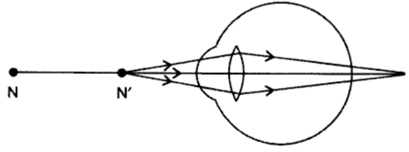
(a) Which defect of vision is represented in this case? Give reason for your answer.
(b) What could be the two causes of this defect?
(c) With the help of a diagram show how this defect can be corrected by the use of a suitable lens.
Answer: (a) Hypermetropia as the image is formed beyond the retina.
(b) (i) Due to greater focal length of the lens and
(ii) As eyeball becomes smaller.
(c) It can be corrected by using a convex lens of suitable focal length as shown below.
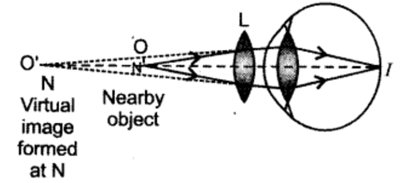
Question 3: Name the part of our eyes that helps us to focus near and distant objects in quick succession.
Answer: Ciliary muscles help in changing the focal length of the eye lens.
Question 4: A person is advised to wear spectacles with concave lenses. What type of defect of vision is he suffering from?
Answer: Myopia or short-sightedness.
Question 5: A person is advised to wear spectacles with convex lenses. What type of defect of vision is he suffering from?
Answer: Hypermetropia or far-sightedness.
Question 6: Why do different components of white light deviate through different angles when passing through a triangular glass prism?
Answer: Due to change in refractive index offered by the medium.
Question 7: A person can comfortably read a book but finds it difficult to read the number on a bus parked 5 m away from him. Name the type of defect of vision he is suffering from. Which type of lens should he use in his spectacles to correct his vision?
Answer: Myopia or short-sightedness. Concave lens should be used to correct his vision.
Question 8: What will be the colour of the sky, when it is observed from a place in the absence of any atmosphere? Why?
Answer: Sky appears dark.
Reason: In the absence of atmosphere, there would have been no scattering of sunlight at all.
Question 9: The sky appears dark instead of blue to an astronaut. State its reason.
Answer: The sky appears dark to the astronaut as scattering does not take place at very high altitude due to the absence of atmosphere.
Question 10: What is Tyndall effect?
Answer: The phenomenon of scattering of light by the colloidal particles is called Tyndall effect.
Question 11: Give an example of optical phenomena which occurs in nature due to atmospheric refraction.
Answer: Twinkling of stars.
Question 12: Give an example of a phenomenon where Tyndall effect can be observed.
Answer: When a fine beam of sunlight enters a room containing suspended particles of dust, the path of the beam of light is visible. It is due to the scattering of light (Tyndall effect).
Question 13: Name the type of particles which acts as a prism in the formation of rainbow in the sky.
Answer: Water droplets present in the atmosphere.
Question 14: What is the cause of dispersion of white light on passing through a prism?
Answer: The refractive index of the material of a prism is different for different colours of light as different colours have different speeds in the material of a prism. Also, prism has nonparallel surfaces.
Question 15: Name the atmospheric phenomenon due to which the sun can be seen above the horizon about two minutes before actual sunrise.
Answer: Atmospheric refraction.
Question 16: Which phenomenon is responsible for making the path of light visible?
Answer: Tyndall effect.
Question 17: State one function of iris in human eye.
Answer: Iris controls the size of pupil.
Question 18: State one function of pupil in human eye.
Answer: Pupil regulates and controls the amount of light entering the eye.
Question 19: State one role of ciliary muscles in the human eye.
Answer: Ciliary muscles help the eye lens to focus the image of an object on the retina by increasing or decreasing the curvature of eye lens.
Question 20: State one function of the crystalline lens in the human eye.
Answer: Crystalline (eye) lens forms a real and inverted image of the object on the retina.
Question 21: State two properties of the image formed by the eye lens on the retina.
Answer:
- Image on the retina is real and inverted.
- Diminished in size.
Question 22: State one function of cornea in human eye.
Answer: Cornea provides the refraction of light rays entering the eye.
Question 23: Why does the sun appear reddish at sunrise?
Answer: At sunrise, the sun looks almost reddish because only red colour ( λb < λr ), which is least scattered is received by our eye and appears to come from the sun. Hence, the appearance of sun at sunrise, near the horizon may look almost reddish.
Question 24: Student sitting at the back bench in a class is not able to see what is written on the blackboard. He however, sees it clearly when sitting on the front seat at an approximate distance of 1.5 m from the blackboard. Draw ray diagrams to illustrate the image formation of the blackboard when he is seated at the (i) back seat (ii) front seat.
Answer: (i) When student is seated at the back seat.

(ii) When student is seated at front seat.
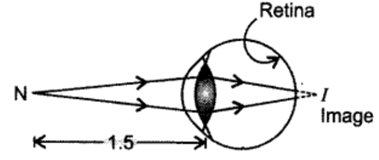
Question 25: What is meant by spectrum of white light? How can we recombine the components of white light after a prism has separated them? Draw a diagram to illustrate it.
Answer: The coloured pattern VIBGYOR formed by a prism by splitting the incident white light is called a spectrum. By having two prisms, inverted to each other, one can recombine the light to get white light again.
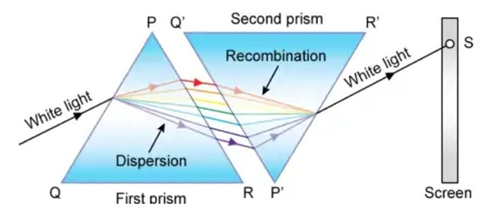
Question 26: Explain why do the planets not twinkle but the stars twinkle.
Answer: Planets being of larger size can be taken as a collection of large number of point-sized objects/sources of light, which nullify the twinkling effect of each other.
Due to varying conditions of atmosphere, starlight undergoes multiple refraction and its path varying slightly while passing through the atmosphere. Therefore, the apparent position of star fluctuates and amount of light entering the eye changing continuously. The star sometimes appear brighter and some other time, it appears fainter. This causes twinkling of star.
Question 27: What is myopia (near-sightedness)? Draw a ray diagram to show how it can be corrected using a lens.
Answer: Myopia is the inability of an eye in viewing long distant objects. The image in this case is formed before the retina. For every myopic eye, there exists a far point beyond which clear image cannot be seen.
The short-sightedness is corrected by using a concave lens which diverges and shifts the image to the retina.
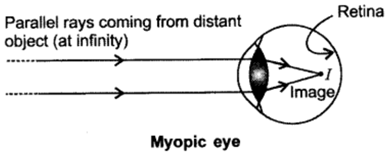
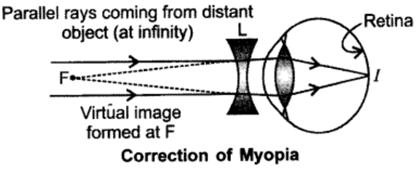
Question 28: What is hypermetropia (far-sighted-ness)? Draw a ray diagram to show how this defect can be corrected using a lens.
Answer: Hypermetropia is the inability of an eye in viewing the nearby objects. The image in this case is formed beyond the retina. For a hypermetropic eye, there exists a near point. It is corrected by using a convex lens, which converges and shifts the image to the retina.
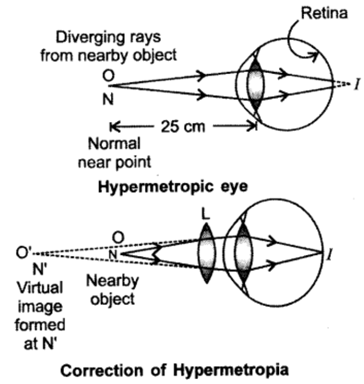
Question 29: Define the term dispersion of white light. State the colour which bends (i) the least and (ii) the most while passing through a glass prism.
Answer: The splitting up of white light into its component colours is called dispersion. The colour which bends (i) the least is red, and (ii) the most is violet, while passing / through a glass prism.
Question 30: Give reasons:
(i) The extent of deviation of a ray of light on passing through a glass prism depends on its colour.
(ii) Lights of red colour are used for danger signals.
Answer: (i) Refractive index of a medium is different for different colours of light.
(ii) Due to large wavelength, red colour is least scattered and travel to large distance.
Question 31: A star appears slightly higher (above) than its actual position in the sky. Illustrate it with the help of a labelled diagram.
Answer: The gradual change in the refractive index of different layers of the atmosphere due to the varying conditions of it causes atmospheric refraction. When starlight enters the atmosphere, it gets refracted continuously. The higher level of air acts as a rarer medium while the dense air near the surface of earth acts as a denser medium. So, the atmosphere bends the starlight towards the normal. As a result, the apparent position of star is slightly different from its actual position. Thus, star appears slightly higher (above) than its actual position in the sky.
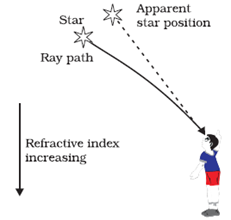
Question 32: Draw a ray diagram to show the refraction of light through a glass prism. Mark on it (a) the incident ray. (b) the emergent ray and (c) the angle of deviation.
Answer: i-incident angle, r – refraction angle, δ – angle of deviation, e – angle of emergence.
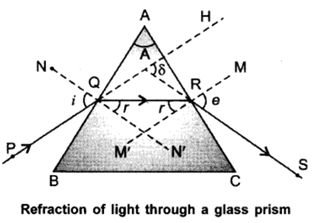
Question 33: A star sometimes appears brighter and some other times fainter. What is this effect called? State the reason for this effect.
Answer: This effect is called Twinkling effect.
Reason: It is due to atmospheric refraction of starlight. The atmosphere has varying layers. The gradual change in the refractive index of different layers of atmosphere causes atmospheric refraction and starlight undergoes multiple refraction. So, the fluctuation in the position of star occurs continuously due to the changing amount of light entering the eye. The star sometimes appears brighter and at some other times, it appears fainter. This causes twinkling of star.
Question 34: What is the colour of the clear sky during day time? Give reason for it.
Answer: Clear sky appears blue.
Reason: When sunlight passes through the atmosphere having the molecules of air and other fine particles, whose size is smaller than the wavelength of visible light, these molecules and particles scatter the blue colour more strongly than the other colours of spectrum as the wavelength of blue colour is more. This scattered blue light enters our eye. So, the colour of sky appears blue to us during day time.
Question 35: What is a spectrum? Why do different coloured rays deviate differently on passing through a glass prism?
Answer: The band of coloured component of a light beam is called its spectrum. The colour sequence is given by the acronym V I B G Y O R — Violet, Indigo, Blue, Green, Yellow, Orange and Red.
The speed of light of different colours in a medium like glass is different. Varying speeds for different colours lead to different refractive indices for different colours. It has been observed that the refractive index of glass for violet colour is more than that for red colour. All the colours present in white light refract through different angles and hence, emerge out from the prism with different directions and become distinct.
Question 36: (a) What is meant by the power of accommodation of an eye?
(b) A person with a myopic eye cannot see objects beyond 1.2 m directly. What should be the type of the corrective lens used? What would be its power?
Answer: (a) The maximum variation in power of the lens so that the far-off and nearby objects are viewed clearly is called power of accommodation.
(b) To correct, an object at infinity has to be brought as an image to 120 cm.
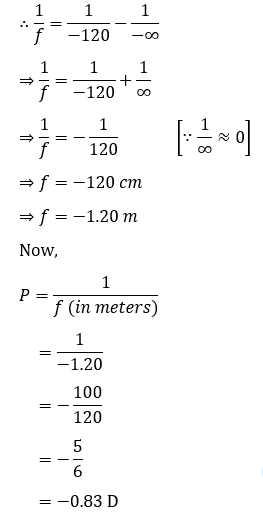
Question 37: (a) What are the values of (i) near point and (ii) far point of vision of a normal adult person?
(b) A student has difficulty in reading the blackboard while sitting in the last row. What could be his defect of vision? Draw a ray diagram to illustrate this defect of vision.
Answer: (a) (i) 25 cm
(ii) Infinity (∞)
(b) Short-sightedness. In this case, the image falls before the retina. It can be corrected by using concave lens.
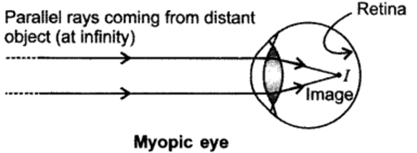
Question 38: Name the three common defects of vision. What are their causes? Name the type of lens used to correct each of them.
Answer: (i) Myopia:
Cause: Elongation of eyeball,
Type of lens used for correction: Concave lens of suitable power.
(ii) Hypermetropia:
Cause: Shrinking of eyeball,
Type of lens used for correction: Convex lens of suitable power.
(iii) Presbyopia:
Cause: Weakening of ciliary muscles,
Type of lens used for correction: Bifocal lens.
Question 39: What is meant by the term ‘power of accommodation’ of human eye? How does it help a person to see nearby as well as distant objects clearly.
Answer: The ability of eye lens to adjust its focal length to form the sharp image of the object at varying distances on the retina is called its power of accommodation. When we see the nearby object, the ciliary muscles contract, it increases the thickness of eye lens. The eye lens then becomes thicker. As a result, the focal length of eye lens decreases in such a way that the clear sharp image of nearby object is formed on the retina. Thus, the object is seen clearly to us.
When we see the distant object, these muscles become relaxed, thus the eye lens becomes thinner, and consequently focal length of the lens increases. Therefore, the parallel rays coming from the distant object are focused on the retina and object is seen clearly to us. Thus, the accommodation power of an eye helps a person to see nearby as well as distant objects clearly.
Question 40: A 14-year old student is not able to see clearly the questions written on the blackboard placed at a distance of 5 m from him.
(a) Name the defect of vision he is suffering from.
(b) With the help of labelled ray diagrams show how this defect can be corrected.
(c) Name the type of lens used to correct this defect.
Answer: (a) Short-sightedness.
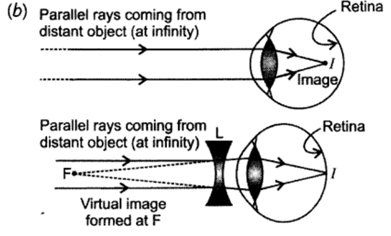
Question 41: (a) What is dispersion of white light? What is the cause of such dispersion? Draw a diagram to show the dispersion of white light by a glass prism.
(b) A glass prism is able to produce a spectrum when white light passes through it but a glass slab does not produce any spectrum. Explain why is it so?
Answer: (a) The splitting up of white light into its constituent colours is called dispersion. The colour sequence is given by the acronym V I B G Y O R – Violet, Indigo, Blue, Green, Yellow, Orange and Red. This colour pattern is called a spectrum.
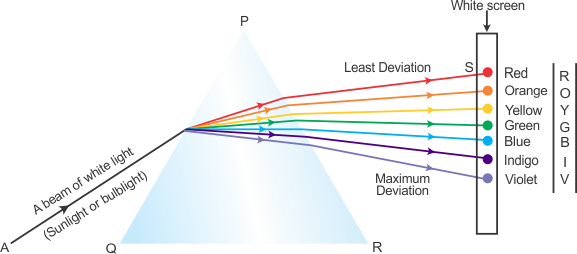
Dispersion takes place because the speed of light of different colours through a glass prism is different and so, refractive index, therefore, each colour bends (refracts) through different angles with respect to incident ray as they pass through a prism. The red colour has maximum speed in glass prism. So, it is least deviated while the violet colour has minimum speed so its deviation is maximum. Thus, the ray of each colour emerges along different paths and becomes distinct.
(b) For dispersion, the two refracting surfaces must be inclined to each other as in case of prism. In rectangular glass slab, the refracting surfaces are parallel to each other. So, dispersion cannot occur. This is due to fact that the rectangular glass slab can be considered as equivalent of two identical prisms in inverted position placed in an inverted position with respect to each other. The deviation and dispersion produced by the second inverted prism is equal and opposite to that produced by the first prism.
Therefore, there will neither be dispersion, nor deviation, Le. second inverted prism recombines the , colour to give a white light parallel to the incident ray again and will undergo only lateral displacement. Hence, rectangular glass slab cannot produce any spectrum.
Question 42: (a) Explain the following terms used in relation to defects in vision and correction provided by them:
(i) Myopia
(ii) Astigmatism
(iii) Bifocal lenses
(iv) Far-sightedness.
(b) Why is the normal eye unable to focus on an object placed within 10 cm from the eye?
Answer: (a) (i) Myopia: Short-sightedness is caused due to excessive curvature in cornea or elongation of eyeball. Image is formed before of the retina. So, a concave lens is used to correct it.
(ii) Astigmatism: The inability to focus the light in both vertical and horizontal lines is called astigmatism. It is caused due to varying curvature in lens both horizontally and vertically. It is corrected by using cylindrical lens.
(iii) Bifocal lenses: These are used to correct presbyopic eye. These contain lenses with upper concave and lower convex surface. Presbyopia arises with age.
(iv) Far-sightedness: Hypermetropia or far-sightedness is caused due to greater focal length of eye lens and/or when eyeball becomes smaller. Image is formed beyond the retina and can be corrected using a convex lens.
(b) The focal length of the lens cannot be changed up to an extent that objects nearer than 25 cm can be viewed (its near point is 25 cm). So it is not able to focus for 10 cm.
Question 43: (a) A student cannot see clearly a chart hanging on a wall placed at a distance 3 m from his eye. Name the defect of vision he is suffering from. Draw a ray diagram to illustrate this defect. List its two possible causes.
(b) Draw a ray diagram to show how this defect may be corrected using a lens of appropriate focal length.
Answer: (a) Myopia or Short-sightedness is the inability of an eye in viewing long distance objects. The image in this case falls before the retina. For every myopic eye, there exists a far point beyond which clear image cannot be seen. Short-sightedness is caused due to
(i) excessive curvature in cornea.
(ii) elongation of eyeball.
(b) The short-sightedness is corrected by using a concave lens which diverges and shifts the image to the retina.
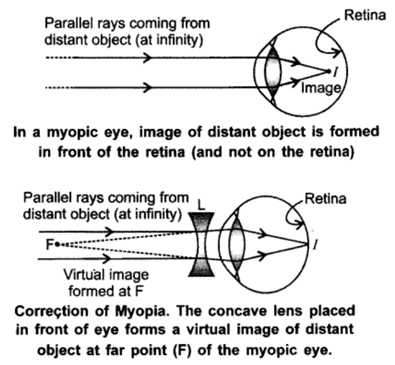
Question 44: An eye donation camp is being organised by social workers in your locality. How and why would you help in this cause?
Answer: Donating eyes help in the following ways:
- A person’s corneal blindness can only be elevated by a human donor’s cornea.
- It is opportunity to restore someone’s sight.
Methods for supporting this cause:
- Make it a family tradition of donating the eyes.
- Motivate and educating others about eye donation.
- Help removing all the myths . about eye donation